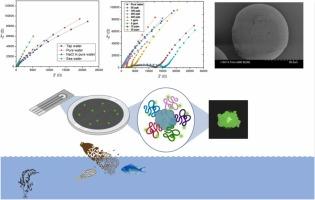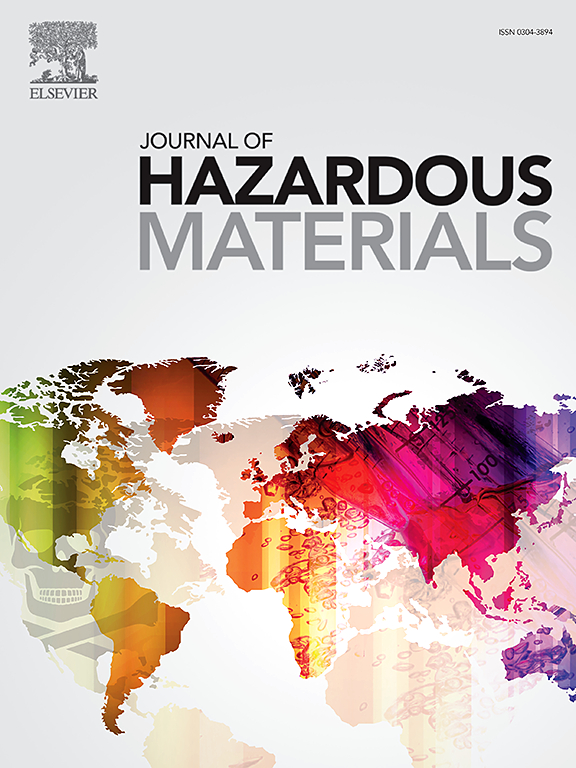Selective On-Site Detection and Quantification of Polystyrene Microplastics in Water Using Fluorescence-Tagged Peptides and Electrochemical Impedance Spectroscopy
IF 12.2
1区 环境科学与生态学
Q1 ENGINEERING, ENVIRONMENTAL
引用次数: 0
Abstract
In this study, we developed a method for the on-site selective detection and quantification of microplastics in various water matrices using fluorescence-tagged peptides combined with electrochemical impedance spectroscopy (EIS). Among the types of plastics found in seawater, polystyrene (PS) microplastics were selected. Fluorometry, scanning electron microscopy (SEM), and Raman spectroscopy were used to verify the specific interaction of these peptides with PS spherical particles of different sizes (ranging from 0.1 to 250 µm). Principal component analysis (PCA) was employed to determine the effects of temperature (25-65 °C), incubation time (5 and 10 minutes), and particle size on plastic-peptide bonding efficiency, based on fluorescence intensity. For each water type (pure, tap, NaCl (0.5 M), and seawater), EIS plots (Nyquist and Bode) were generated. Significant factors affecting the EIS response, including particle size, shape, and material, were analyzed by measuring electrical parameters for different microplastic concentrations (50 ppb to 20 ppm). The EIS parameters changed with increasing plastic concentration, determining a limit of detection (LOD) of 50 ppb (ng/mL) for pure and tap water and 400 ppb for saline water, as the lowest concentration producing a significant change in EIS parameters compared to the baseline. The sensor proved highly effective for detecting microplastics in low ionic strength environments such as pure and tap water. However, in high ionic strength environments like saline and seawater, the detection capability diminished, likely due to the masking effect of ions on the EIS response.

利用荧光标记肽和电化学阻抗光谱法对水中的聚苯乙烯微塑料进行选择性现场检测和定量
在这项研究中,我们开发了一种利用荧光标记肽结合电化学阻抗光谱(EIS)对各种水基质中的微塑料进行现场选择性检测和定量的方法。在海水中发现的塑料类型中,选择了聚苯乙烯(PS)微塑料。利用荧光测定法、扫描电子显微镜(SEM)和拉曼光谱来验证这些肽与不同大小(0.1 至 250 微米)的 PS 球形颗粒之间的特定相互作用。根据荧光强度,采用主成分分析法(PCA)确定温度(25-65 °C)、培养时间(5 和 10 分钟)和颗粒大小对塑料肽键合效率的影响。对于每种水(纯水、自来水、NaCl(0.5 M)和海水),都生成了 EIS 图(奈奎斯特图和博德图)。通过测量不同微塑料浓度(50 ppb 至 20 ppm)的电参数,分析了影响 EIS 响应的重要因素,包括颗粒大小、形状和材料。EIS 参数随着塑料浓度的增加而变化,纯水和自来水的检测限(LOD)为 50 ppb(纳克/毫升),盐水的检测限(LOD)为 400 ppb,这是 EIS 参数与基线相比发生显著变化的最低浓度。事实证明,在纯净水和自来水等低离子强度环境中,传感器能非常有效地检测微塑料。然而,在盐水和海水等高离子强度环境中,检测能力下降,这可能是由于离子对 EIS 响应的掩蔽效应。
本文章由计算机程序翻译,如有差异,请以英文原文为准。
求助全文
约1分钟内获得全文
求助全文
来源期刊

Journal of Hazardous Materials
工程技术-工程:环境
CiteScore
25.40
自引率
5.90%
发文量
3059
审稿时长
58 days
期刊介绍:
The Journal of Hazardous Materials serves as a global platform for promoting cutting-edge research in the field of Environmental Science and Engineering. Our publication features a wide range of articles, including full-length research papers, review articles, and perspectives, with the aim of enhancing our understanding of the dangers and risks associated with various materials concerning public health and the environment. It is important to note that the term "environmental contaminants" refers specifically to substances that pose hazardous effects through contamination, while excluding those that do not have such impacts on the environment or human health. Moreover, we emphasize the distinction between wastes and hazardous materials in order to provide further clarity on the scope of the journal. We have a keen interest in exploring specific compounds and microbial agents that have adverse effects on the environment.
 求助内容:
求助内容: 应助结果提醒方式:
应助结果提醒方式:


